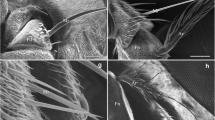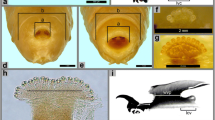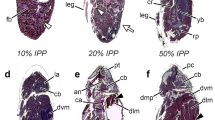Abstract
Surface ultrastructure of the puparia of the blow fly, Lucilia cuprina, and flesh fly, Liosarcophaga dux, are presented utilizing scanning electron microscopy (SEM). Emphasis was focused on characteristic features of the puparia that could be used for differentiation from other forensically important fly species. The puparium of L. cuprina typically measures 6.2±0.2 mm in length and 2.3±0.1 mm in width. Each anterior spiracle contains a single row of 5–7 papillae. The intersegmental spines between the prothorax and mesothorax are triangular with constricted tips. A clustered bubble membrane, comprising about 30 mammillate structures, is positioned dorsolaterally on each side of the first abdominal segment in young puparia but is replaced by short, tubular respiratory horns in aged puparia. The posterior end of the puparium is broadly truncate and bears a pair of medially positioned posterior spiracles that each contains three straight spiracular slits. The puparium of L. dux is larger in comparison to L. cuprina and typically measures 9.9±0.3 mm in length and 3.8±0.2 mm in width. An anterior spiracle of this species contains 14–17 papillae. The intersegmental spines between the prothorax and mesothorax are broad and triangular. A convoluted structure of unknown function was observed at the dorsolateral edge of segments 5–11. In L. dux, the caudal segment of the puparium is slightly tapered and abruptly truncated and contains a pair of posterior spiracles that are located within a deep concavity in the terminal end. Each posterior spiracular disc appears D-shaped, with a pronounced medial projection and three vertically oriented long, narrow spiracular slits. The anatomical features presented herein may be useful for identification of fly puparia of these two species in future forensic entomological investigations.



















Similar content being viewed by others
References
Byrd JH, Castner JL (2001) Insects of forensic importance. In: Byrd JH, Castner JL (eds) Forensic entomology: the utility of arthropods in legal investigations. CRC, Florida, pp 43–79
Castner JL (2001) General entomology and arthropod biology. In: Byrd JH, Castner JL (eds) Forensic entomology: the utility of arthropods in legal investigations. CRC, Florida, pp 17–41
Colditz IG, Watson DL, Eisemann CH, Tellam RL (2002) Production of antibodies to recombinant antigens from Lucilia cuprina following cutaneous immunization of sheep. Vet Parasitol 104:345–350
Erzinclioglu Z (2000) Maggots, murder and men. St. Martin’s, New York
Goff ML (2000) A fly for the prosecution. How insect evidence helps solve crimes. Harvard University Press, Cambridge, MA
Greenberg B, Kunich JC (2002) Entomology and the law. Flies as forensic indicators. Cambridge University Press, Cambridge, MA
Kano R, Shinonaga S (1994) Studies on the sarcophagid flies from Nepal (Diptera: Sarcophagidae). Jpn J Sanit Zool 45:253–275
Keilin D (1944) Respiratory systems and respiratory adaptations in larvae and pupae of Diptera. Parasitology 36:1–66
Kitching RL (1976) The immature stages of the old-world screw-worm fly, Chrysomya bezziana Villenuve, with comparative notes on other Australasian species of Chrysomya (Diptera, Calliphoridae). Bull Entomol Res 66:195–203
Liu D, Greenberg B (1989) Immature stage of some flies of forensic importance. Ann Entomol Soc Am 82:80–93
Sandeman RM, Collins BJ, Carnegie PR (1987) A scanning electron microscope study of L. cuprina larvae and the development of blowfly strike in sheep. Int J Parasitol 17:759–765
Siriwattanarungsee S, Sukontason KL, Kuntalue B, Piangjai S, Olson JK, Sukontason K (2005) Morphology of the puparia of the housefly, Musca domestica (Diptera: Muscidae) and blowfly, Chrysomya megacephala (Diptera: Calliphoridae). Parasitol Res 96:166–170
Smith KGV (1986) A manual of forensic entomology. Cornell University Press, Ithaca, NY
Stevens J, Wall R (1997) The evolution of ectoparasitism in the genus Lucilia (Diptera: Calliphoridae). Int J Parasitol 27:51–59
Sukontason K, Sukontason KL, Piangjai S, Chaiwong T, Boonchu N, Kurahashi H, Vogtsberger RC (2003) Larval ultrastructure of Parasarcophaga dux (Thomson) (Diptera: Sarcophagidae). Micron 34:359–364
Sukontason K, Sukontason KL, Ngern-klun R, Sripakdee D, Piangjai S (2004) Differentiation of the third instar of forensically important fly species in Thailand. Ann Entomol Soc Am 97:1069–1075
Tellam RL, Eisemann CH, Vuocolo T, Casu R, Jarmey J, Bowles V, Pearson R (2001) Role of oligosaccharides in the immune response of sheep vaccinated with Lucilia cuprina larval glycoprotein, peritrophin-95. Int J Parasitol 31:798–809
Zumpt F (1965) Myiasis in man and animals in the old world. Butterworths, London
Acknowledgements
We thank Budsabong Kuntalue for technical assistance. We are grateful to the Faculty of Medicine, Chiang Mai University, and the Thailand Research Fund for their support.
Author information
Authors and Affiliations
Corresponding author
Rights and permissions
About this article
Cite this article
Sukontason, K.L., Piangjai, S., Bunchu, N. et al. Surface ultrastructure of the puparia of the blow fly, Lucilia cuprina (Diptera: Calliphoridae), and flesh fly, Liosarcophaga dux (Diptera: Sarcophagidae). Parasitol Res 98, 482–487 (2006). https://doi.org/10.1007/s00436-005-0102-y
Received:
Accepted:
Published:
Issue Date:
DOI: https://doi.org/10.1007/s00436-005-0102-y




